The 10 Best AWS Cloud Optimization Consulting Firms for CPG and Retail Teams
August 25, 2025

You’re likely managing complex AWS workloads that support everything from seasonal traffic spikes to always-on customer experiences. At the same time, you’re under pressure to keep costs low, maintain uptime, and meet compliance benchmarks.
That’s why having the right partner to help you streamline your cloud infrastructure can make a measurable difference. But the truth is that not every provider understands the demands of modern CPG and retail operations, or how to balance technical performance with financial accountability.
This guide helps you choose the right AWS cloud optimization partners for retail growth. You’ll compare leading firms, weigh your options, and see who actually delivers in high-stakes environments.
But first, let’s cover the basics before doing anything else.
What Are AWS Cloud Optimization Consulting Services?
AWS cloud optimization consulting services help you improve the performance, reliability, and cost-efficiency of your AWS environment through expert analysis, automation, and ongoing support. They typically involve cloud strategies such as architectural reviews, infrastructure automation, and long-term support through monitoring and governance.
Most providers also focus on security and compliance, which are key concerns if you’re running sensitive workloads across multiple regions. According to Flexera’s 2025 report, organizations are still wasting an estimated 27% of their IaaS and PaaS cloud spend. That’s a major reason to take optimization seriously.
To learn more about what AWS entails, feel free to check out this YouTube video:
Next, let’s look at why these services matter specifically for retail and CPG environments like yours.
Why Do You Need AWS Cloud Optimization Consulting Services?
You probably already see that unchecked cloud spending and technical gaps quickly erode margins in retail and CPG. Many companies only notice overspending after the bill arrives (70%).
That’s why cloud optimization can help. After all, implementing it right is how you ensure your cloud delivers consistent performance at the right price point. AWS also reports a 57% drop in downtime after optimizing architecture, which shows these services deliver a measurable impact.
Here are the benefits you can expect:
- Reduce unnecessary AWS spend through cost right-sizing and automation.
- Improve availability and performance for high-traffic CPG and retail applications.
- Strengthen security and compliance posture across cloud environments.
- Accelerate time-to-market using cloud-native features such as CI/CD and serverless computing.
- Simplify management of distributed architecture and seasonal scaling.
- Enable better visibility and accountability for cloud costs via dashboards and tagging.
- Minimize risk of outages or performance issues during peak events.
So what can you do next? Evaluate providers that align with your operational peaks, security demands, and power your digital roadmap. To do that, you can use the following section to compare top AWS partners tuned to your needs.
Pro tip: Pair your AWS optimization with smart digital transformation strategies that drive ROI in retail.
Top 10 AWS Cloud Optimization Consulting Firms for CPG & Retail
If you’re looking to reduce waste and boost performance across your AWS architecture, picking the right consulting partner is key. Here are ten firms known for their precision, speed, and experience with CPG and retail cloud environments.
1. Nova Cloud

Nova Cloud is an AWS advanced tier services partner with a sharp focus on helping CPG and retail teams cut costs, scale fast, and stay resilient during peak traffic. What sets us apart is deep industry alignment and a practical delivery model.
Our engineers work across U.S. and LATAM time zones, so real-time collaboration comes built in. With us, you’re not chasing answers. You’re working side-by-side with AWS-certified professionals who know retail workloads, such as how to handle sudden traffic spikes or sync inventory in real time.
We support your full AWS lifecycle, from cloud architecture and cost reviews to DevOps automation, post-migration FinOps, and 24/7 support. Nova Cloud also offers pre-built playbooks based on real retail scenarios, so you don’t have to start from scratch.
Clients such as FullBeauty Brands have already achieved $250K ROI gains through optimization work. If your goal is ongoing AWS efficiency, not just a one-off review, then Nova Cloud is ready to support you long-term.
Key features:
- AWS retail competency recognition.
- Nearshore AWS-certified teams for real-time delivery.
- CI/CD pipelines and Infrastructure as Code automation.
- Post-migration FinOps and cost monitoring services.
- Retail playbooks for IoT, GenAI, and e-commerce use cases.
Pros:
- Strong retail and CPG industry focus.
- Full lifecycle AWS support from migration to FinOps.
- Proven cost savings and performance impact.
- Seamless collaboration across time zones.
Cons:
- Nova focuses purely on technical execution.
Website: novacloud.io
Pricing: Custom quote.
2. nOps
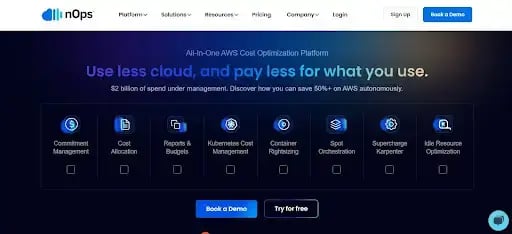
nOps is an automated AWS cost and governance platform focused on cloud-savvy teams, especially in retail and CPG. It continuously monitors your AWS environment against the AWS Well‑Architected Framework, flags anomalies, and applies cost-saving actions automatically.
Its real-time compliance tracking and machine learning–driven resource management help you avoid waste before it hits your balance sheet. You get hands-off control over compute scaling, RI/Savings Plan optimization, rightsizing, and unused resource cleanup, which keeps your environment lean, efficient, and audit-ready.
Key features:
- Automated cost optimization and rightsizing.
- Continuous compliance checks vs. AWS best practices.
- Real-time change tracking and anomaly alerts.
- Automated reserved instance & savings plan management.
- Unified dashboard for cost, performance, and compliance insights.
Pros:
- Delivers automation with minimal manual work.
- Alignment with AWS architecture guidelines.
- Useful for teams focused on consistent cost governance.
Cons:
- It can feel complex for new users.
- Limited support for non-AWS or hybrid cloud environments.
- Some reporting capabilities might require paid add‑ons.
Website: nops.io
Pricing: Custom quote.
3. Cloudability (Apptio Cloudability)

Cloudability provides enterprise-level cost visibility and governance for AWS and multi-cloud environments. You get normalized billing data, forecasting, and allocation tools that help you map cloud spend back to your team or business units.
The platform focuses heavily on FinOps discipline, such as budgeting, scenario planning, and chargeback/ showback. These capabilities give stakeholders clear visibility into usage and help them ensure accountability across teams.
Besides, Cloudability’s planning tools help forecast spend for seasonal demand, while rightsizing dashboards identify cost levers in idle or oversized resources.
Key features:
- Central cost visibility across AWS and other clouds.
- Granular cost allocation and chargeback support.
- Budgeting, forecasting, and predictive analytics.
- Rightsizing and governance policy enforcement.
- Collaboration tools for IT, finance, and engineering alignment.
Pros:
- Meant for large, multi-account cloud environments.
- Structured FinOps support and forecasting.
- Governance and cross-team collaboration support.
Cons:
- Onboarding is time‑intensive and requires disciplined tagging.
- Steep learning curve for novice users.
Website: apptio.com
Pricing: Custom quote.
4. Densify

Densify is a cloud and container resource optimization platform that uses machine learning to fine-tune your AWS infrastructure for efficiency and performance. And it integrates with CI/CD pipelines and tools such as Terraform or CloudFormation to automate infrastructure adjustments.
Another advantage is that It gives you detailed visibility into usage patterns, such as CPU, memory, and I/O. You will also get precise recommendations for instance sizing, auto-scaling groups, and Kubernetes cluster adjustments.
Of course, Densify respects your Reserved Instance commitments, deferring changes until after they expire.
Key features:
- ML‑powered rightsizing for EC2, RDS, and containers.
- Kubernetes/EKS cluster resource tuning.
- Dashboards for utilization trends and optimization insights.
- CI/CD and IaC integration for automated deployment of changes.
Pros:
- Delivers automated capacity tuning with minimal manual effort.
- Supports both cloud and container environments.
- Provides clear visibility into under‑used or over‑allocated resources.
Cons:
- May overlook business‑context variables such as revenue per app.
- Doesn’t integrate out‑of‑the‑box with some ITSM tools.
- The reporting interface can lack details in storage and network metrics.
Website: densify.com
Pricing: Starts at $2.50 per instance per month (volume discounts apply).
5. Zesty
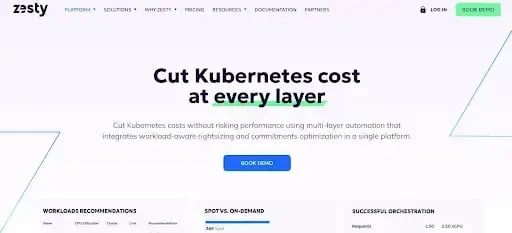
Zesty is a cloud spend automation tool that adjusts AWS resource usage in real time. It focuses on compute and storage provisioning, using AI to dynamically resize infrastructure without manual input.
Unlike traditional schedulers or scripts, Zesty reacts to demand instantly, so your systems always align with actual usage. That includes shrinking over-provisioned resources during low-traffic periods or scaling up during sudden traffic spikes.
The platform also helps optimize AWS block storage through Zesty Disk, which expands or contracts EBS volumes automatically based on consumption.
Key features:
- Real-time resource scaling and storage resizing.
- Automatic EBS volume management with Zesty Disk.
- Hands-off infrastructure tuning powered by AI.
- Designed for unpredictable or bursty traffic.
Pros:
- Runs with little to no manual oversight.
- Reduces EC2 and storage costs quickly.
- Setup is simple and fast.
Cons:
- Limited support for broader AWS services.
- Dashboards lack advanced granularity.
- Contracting via AWS Marketplace can be clunky.
Website: zesty.co
Pricing: $500 base monthly fee + $5 per vCPU per month
6. CloudZero
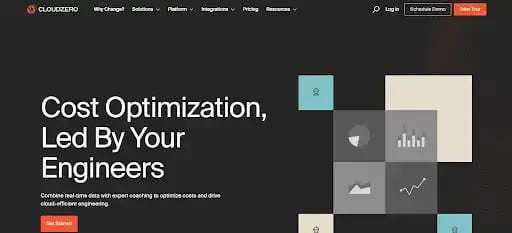
CloudZero is a cloud cost intelligence tool built to align engineering and finance around meaningful metrics. It not only shows total AWS spend, but it also breaks it down by product, feature, team, or customer, even if tagging is incomplete.
So instead of just flagging budget spikes, CloudZero helps you understand what’s driving them. You can see which product or team is responsible, why costs are increasing, and make smarter decisions, like whether to refactor a service or revisit pricing.
Key features:
- Business-context insights without strict tagging.
- Dashboards and alerts for engineers.
- Cost-per-product and per-customer visibility.
- Multi-source integration (AWS, Snowflake, Kubernetes).
- Built-in FinOps collaboration tools.
Pros:
- Support for unit economics tracking.
- Easy to explore and visualize usage.
- Works without deep tagging.
Cons:
- Limited integrations with workflow tools.
- Report configuration can be clunky.
- Azure visibility is still developing.
Website: cloudzero.com
Pricing: Custom quote.
7. FinOut
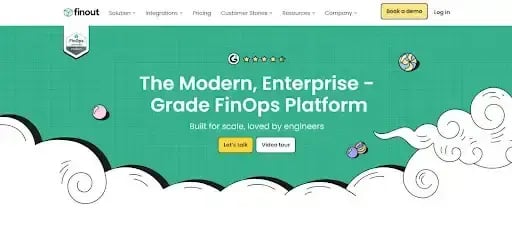
FinOut gives you a unified view of cloud and SaaS costs and is built for teams juggling multiple vendors and services. Instead of managing dozens of billing tools, you get a “MegaBill” that combines AWS, Google Cloud, Snowflake, Kubernetes, and other SaaS platforms in one place. That helps you quickly understand total spend across business units, even if teams use different tags or accounts.
The platform is helpful when trying to trace full costs for a product or department. It also gives you the controls to allocate shared cloud resources fairly and alert teams when usage drifts outside expectations.
Key features:
- Consolidated billing view across AWS, SaaS, and Kubernetes.
- Custom cost centers and business breakdowns.
- Dashboards and alerting for usage spikes.
- Shared resource cost attribution.
- Built-in anomaly detection and insights.
Pros:
- Supports detailed business-level cost views.
- Flexible tagging without needing upstream changes.
- Helps enforce budget rules across teams.
Cons:
- Navigation can feel overwhelming.
- Performance can lag on large accounts.
- A few features are still under development.
Website: finout.io
Pricing: Starts at $1,000/month (for up to $500K annual spend).
8. Flexera
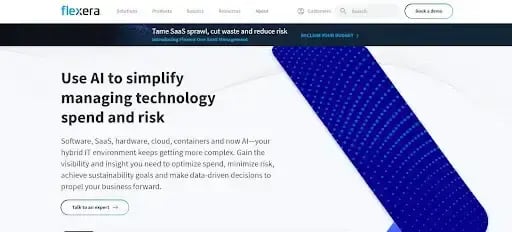
Flexera is built for enterprises that need to manage and optimize cloud and on-prem IT costs across a complex landscape. It’s part of the Flexera One platform, which means it brings together cloud cost visibility, policy automation, and software license tracking into one interface. That’s helpful if you’re juggling AWS, Azure, and GCP alongside on-prem environments.
What makes Flexera different is how it ties cloud cost control to IT asset management. You can track licenses, avoid compliance risks, and apply cost allocation policies without switching platforms. It also gives you granular chargeback tools, so you can assign cloud spend to business units such as merchandising or logistics.
Key features:
- Multi-cloud and hybrid infrastructure visibility.
- Policy-based cloud governance automation.
- Cost allocation and chargeback tools.
- IT asset and license compliance tracking.
- Workflow sharing across business units.
Pros:
- Unifies IT asset and cloud cost management.
- Supports large-scale, policy-driven governance.
- Custom dashboards for finance and engineering.
Cons:
- Steep setup and learning curve.
- It can be too costly for smaller businesses.
- Complex UI with many moving parts.
Website: flexera.com
Pricing: Custom quote.
9. ProsperOps
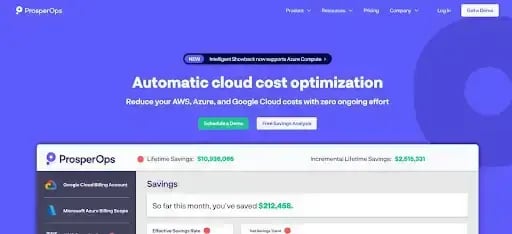
ProsperOps automates AWS commitment management to help you maintain high discount coverage without the manual work. It runs as a background service that buys, modifies, or sells commitments such as Reserved Instances and Savings Plans based on your actual usage. That way, you’re not guessing when to commit or worrying about underutilized purchases.
For example, if your EC2 usage spikes due to a seasonal e-commerce campaign, ProsperOps adjusts coverage automatically to secure savings. It tracks trends and reshapes your portfolio daily, so your AWS cost optimization is always current.
Key features:
- Full automation of AWS commitment management.
- Machine-learning-based usage forecasting.
- Continuous savings performance tracking.
- Savings dashboard with detailed financial metrics.
- Performance-based pricing model.
Pros:
- Hands-off way to optimize AWS discount coverage.
- Smart blending of commitment types.
- Transparent financial reporting for finance teams.
Cons:
- Doesn’t manage usage or resource sizing.
- Pricing is tied to savings, not a flat rate.
- Less effective with fluctuating or spiky workloads.
Website: prosperops.com
Pricing: Custom quote.
10. Datadog

Datadog extends its observability platform to include cloud cost monitoring, which provides your team with full visibility into spend, usage, and infrastructure performance in one place. Its Cloud Cost Management tool lets you track AWS, Azure, GCP, Kubernetes, and SaaS usage alongside application metrics.
That integration helps surface cost anomalies in the same dashboards where you already manage system health. For example, you can identify a spike in compute costs and tie it directly to a code deployment or traffic surge.
Datadog also provides granular cost breakdowns by service or feature and includes automated recommendations for optimizing resources. It supports workflows that trigger auto-scaling or alerting based on usage or cost changes.
Key features:
- Cloud and application cost data in one dashboard.
- Integrated anomaly alerts tied to deployments.
- Automated cost-saving suggestions.
- Tag-based cost breakdowns across clouds and Kubernetes.
- Budget tracking and FinOps dashboard tools.
Pros:
- Performance and cost observability integration.
- Third-party cloud and SaaS support.
- Alerting and real-time dashboards.
Cons:
- Pricing is steep and scales fast with usage.
- Value depends on your need for centralized insights.
- Doesn’t function as a standalone AWS cost optimization solution.
Website: datadoghq.com
Pricing: Starts at $15 per host/month with a 14-day free trial available.
Pro tip: If you’re already using Datadog for observability, here’s how it powers DevOps for eCommerce without the blind spots.
How to Choose AWS Cloud Optimization Consulting Services
Finding the right AWS cloud optimization consulting partner can shape both your cost performance and day-to-day operations. But with so many providers out there, the real challenge is knowing what to prioritize.
Here are the practical steps you should take to choose the right partner for you and your team:
- Prioritize firms with proven experience in retail and CPG workloads, including omnichannel systems and handling seasonal traffic spikes.
- Make sure they align cost savings with uptime, compliance, and business performance goals, not just discounting.
- Look for those using Infrastructure as Code (IaC) and automation to maintain continuous optimization across deployments.
- Don’t overlook cloud security and governance capabilities. The right partner protects your data while cutting costs.
- Check if their tooling works with your existing AWS accounts, tagging methods, and cloud budgets.
- Look at post-launch support. Will they give you monthly reports, shared dashboards, and clear points of accountability?
- Last, check timezone alignment and how they integrate into your workflows. Whether you run 24/7 DevOps or lean FinOps teams, they should work with your pace.
Evaluate these areas carefully. A smart choice now helps you get lasting value from your AWS consulting services.
Ready to Cut AWS Costs Without Compromising Performance?
If you’re managing AWS at scale in retail or CPG, then cost control without slowing growth is your biggest challenge. That’s where we come in. At Nova, we align AWS cloud strategies with retail realities, such as spiky traffic, strict SLAs, and tight budgets.
Our engineers hold top AWS certifications and bring deep experience in cloud-native development, automation, and 24/7 support. We work directly with your teams to fix root issues fast.
If you want to lower your spend and boost uptime without adding overhead, schedule a call with our team. We’re ready when you are.
FAQs
What is optimization in AWS Cloud?
It’s the process of improving how your AWS environment runs by reducing waste, lowering costs, and improving performance. This includes rightsizing compute resources, refining storage use, and using tools such as AWS DevOps for automation.
Can AWS cloud optimization help manage seasonal traffic spikes in retail?
Yes. By building in elasticity with auto-scaling and using cost-aware load distribution, you can stay responsive during peak events while keeping overhead low during off-seasons.
How often should CPG and retail companies review their AWS cloud architecture for cost and performance?
Quarterly reviews are a solid baseline. That’s usually enough to catch issues early while aligning with changing business priorities or new product launches.
Is it possible to optimize AWS costs without risking site performance during peak sales periods?
Absolutely. With the right cloud strategies, such as performance testing and real-time monitoring, you can scale safely and avoid overpaying. Solutions architects typically guide this balance.
Comments